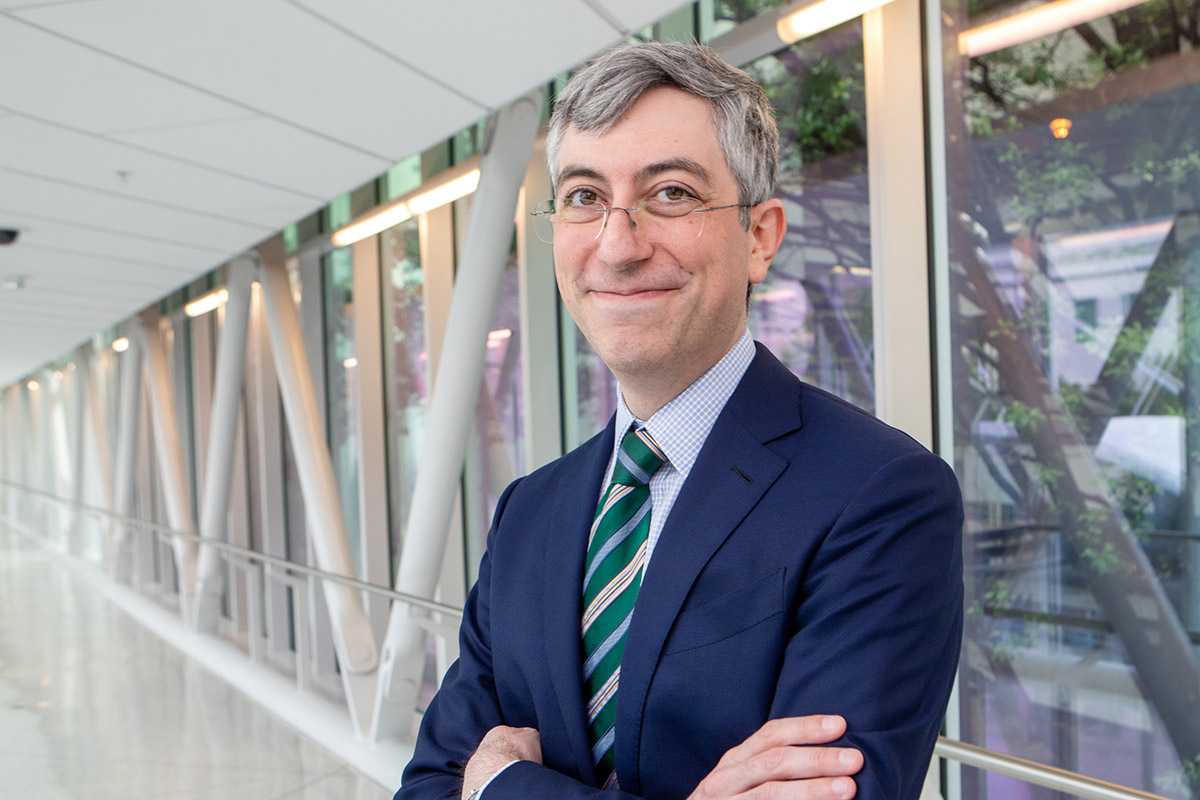To be able to tell a patient that a new therapy just got across the finish line because of what they did, and that others will live longer and better because of it — that’s one of the most powerful experiences we can have as oncologists.
As an expert in caring for patients with neuroendocrine tumors (NETs), Daniel M. Halperin, MD, is drawn to the complexity of these rare cancers and the impact that thoughtful care can have on patients’ lives. “I think my interest in becoming an oncologist and a physician really started at the level of understanding what goes wrong at a cellular level,” he says. “I’m motivated to help people live longer and better lives with all of the newest therapies.”
Halperin is a medical oncologist at Winship Cancer Institute of Emory University and associate professor and vice chair for clinical affairs in the Department of Hematology and Medical Oncology at Emory University School of Medicine.
Understanding neuroendocrine tumors

Halperin with a patient in the exam room.
Neuroendocrine tumors arise from hormone-producing cells located throughout the body and can develop in organs such as the pancreas, lungs or gastrointestinal tract. Each year, more than 28,000 people in the U.S. are diagnosed with this relatively rare and complex cancer, which can sometimes produce hormones that cause distinctive symptoms in addition to tumor growth.
“Neuroendocrine tumors can cause both cancer-related and hormone-related symptoms,” Halperin explains. “They can make people quite uncomfortable, and because the disease is so uncommon, the data to guide treatment are limited. That means care often depends on thoughtful, individualized decision-making.”
That’s why, he says, patients benefit most from being treated by subspecialists familiar with the nuances of the disease. “It’s increasingly important for people with NETs to involve specialists in their care — people who see this every day and can help make those really nuanced decisions with them,” Halperin says.
Building a team-based program
At Winship, Halperin leads efforts to grow and strengthen a comprehensive neuroendocrine tumor program. “We’ve been focused on building our program and bringing together a team of experts across surgery, medical oncology, nuclear medicine, interventional radiology and pathology,” he says. “That kind of collaborative, multidisciplinary approach is what truly sets Winship apart.”
Halperin and his team are also working to expand access to cutting-edge clinical trials. “For our patients, we’re working to bring the newest therapies we possibly can,” he says. These include novel radioligand and targeted alpha therapies that deliver radiation directly to cancer cells through molecular “addresses” on their surfaces, as well as new CAR T cell therapies being tested in early clinical trials for neuroendocrine tumors.
“We’re one of only a handful of sites in the country administering CAR T therapy for neuroendocrine tumors,” Halperin says. “It’s incredibly exciting to be part of that early story.”
The importance of clinical trials
Clinical research, Halperin says, is central to improving outcomes for patients with rare cancers. “Every advance we’ve made in neuroendocrine tumor care, every new line of therapy that helps people live longer exists because patients have chosen to participate in clinical trials,” he says.
He recalls moments that highlight how meaningful those contributions are. “To be able to tell a patient that a new therapy just got across the finish line because of what they did, and that others will live longer and better because of it—that’s one of the most powerful experiences we can have as oncologists.”
Bringing care and science together
Beyond research, Halperin is committed to ensuring patients can access expert care quickly and seamlessly. “We’ve worked hard to make sure patients can be seen promptly by a specialized, multidisciplinary team that can evaluate their case and create a unified plan,” he says. “That approach really improves the experience for patients and families.”
When asked what “Where Science Becomes Hope” means to him, Halperin says it’s about the direct connection between innovation and impact. “For me, it’s at the intersection of offering new therapies to people who need them and delivering that care in innovative ways,” he says. “That’s what Winship is here to do — and why I come to work every day.”
Winship is where science becomes hope.
Who have you observed inspiring hope in our patients, our team or our community? We would love to hear from you. If you have a story to share about someone inspiring hope at Winship, reach out to us using this form.

